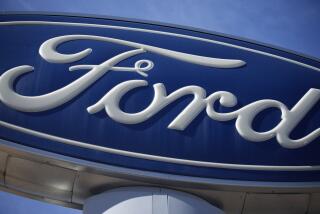To boost future mileage, carmakers are likely to rely on today’s advanced technology
In 2025, when the auto industry will be required to meet a 54.5-miles-per-gallon fuel economy target that the Obama administration plans to announce Friday, the vehicles Americans buy may not look very different from those on the road today.
But what will be under the hood is another story, industry and environmental experts say.
From pickup trucks and sport utility vehicles to hybrids and subcompact cars, almost every vehicle sold in the U.S. is likely to feature the kinds of advanced technology now confined to the most fuel-efficient.
Although the new standard will be a big numerical step upward, experts say, the secret to achieving it is not some huge breakthrough. Rather, the key will be applying what’s already known or on the drawing boards to almost every vehicle, not just a relative handful.
“You have to look at a vehicle not just as one thing that will put you over the goal line but all sorts of different things that will help you,” said Richard Truett, a Ford Motor Co. spokesman. “We have a head start on that. But everyone has to do it.”
Not every truck and SUV will have to get the higher mileage. The standard will be applied to the so-called fleet average, a complex calculation of the combined fuel efficiency of all the vehicles sold by a manufacturer in a model year. That means some gas guzzlers can still be sold; they just have to be offset by a larger number of highly fuel-efficient cars.
After weeks of intensive talks at the White House with regulatory agencies, automakers, the state of California and environmentalists, President Obama plans to make a speech in Washington on Friday to outline a plan for boosting fuel economy standards beginning in 2017 and reaching a fleet-wide average of 54.5 mpg by 2025.
The new requirements build on rules starting for model year 2012 that seek to push up fuel economy to 34.1 mpg by 2016. The more efficient cars and trucks are also expected to drive down the greenhouse gas emissions linked to global warming.
Right now, the American fleet of passenger vehicles averages only about 27.8 mpg.
Automakers and the state of California have voiced support for the 2025 plan.
After a meeting at the White House on Wednesday, environmentalists also offered tentative support, adding that they need more details about closing what they say are loopholes that automakers have used in the past to avoid the most stringent targets.
“After decades of inaction, President Obama is ensuring we see significant improvements to new vehicles, and that is significant for both cutting our addiction to oil and curbing global warming,” said Ann Mesnikoff, director of the Sierra Club’s green transportation campaign.
“However, we have not seen the oil savings and greenhouse gas reductions yet — and those are the critical measures of the program.”
Skepticism about the efficacy of new mileage targets stems in part from how they are derived and applied. The conditions for testing fuel economy have only a limited similarity to real-world driving: Cars are run in a lab at a steady speed, with the air conditioner and radio turned off.
Moreover, each automaker probably will have a different standard applied to it by regulators after a political concession made in 2007 to get the support of domestic automakers.
That would mean General Motors Co., Ford and Chrysler Group, whose fleets are filled with big vehicles, will probably have to meet a lower average fuel economy standard, while automakers like Honda Motor Co. and Hyundai Motor Co., which tilt toward smaller vehicles, will have a higher fuel-economy requirement.
Companies such as Ford are focusing on improving internal combustion engines by making them smaller to boost mileage by saving weight, then outfitting them with direct fuel injection and turbochargers to give them power.
At the same time, industry experts say, hybrid technology will become more widespread and cheaper. And automakers will turn to advanced materials, including carbon fiber and high-strength steel, to make cars lighter. Ford, for instance, plans to take 250 to 750 pounds out of its vehicles between 2013 and 2017.
The appeal of revised technology can be seen in Ford’s deployment of its Eco-boost technology. The 2012 Eco-Boost Ford Explorer is expected to get 28 mpg on the highway compared with 21 mpg for the 2010 conventional version. The Eco-Boost F150 full-size pickup truck, introduced just six months ago, now accounts for 41% of all F150 sales.
More to Read
Inside the business of entertainment
The Wide Shot brings you news, analysis and insights on everything from streaming wars to production — and what it all means for the future.
You may occasionally receive promotional content from the Los Angeles Times.











